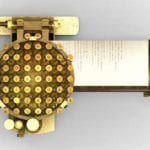 Mysteries
Mysteries  Mysteries
Mysteries  History
History 10 Surprising Stories About the Texas Rangers
 Humans
Humans 10 Philosophers Who Were Driven Mad by Their Own Theories
 Miscellaneous
Miscellaneous 10 Video-Game-Worthy Weapons and Armors from History
 Weird Stuff
Weird Stuff 10 Psychics Who Accurately Predicted Wartime Events
 The Arts
The Arts 10 Pieces of Art Inspired by a Broken Heart
 Health
Health 10 Science Fiction-Sounding New Medical Treatments
 History
History 10 Surprising Facts About the Father of Submarine Warfare
 Space
Space Ten Astonishing New Insights into Alien Worlds
 Weird Stuff
Weird Stuff 10 Bizarre Summer Solstice Rituals Still Practiced Today
 Mysteries
Mysteries Top 10 Haunting Facts About the Ghost Ship MV Alta
 History
History 10 Surprising Stories About the Texas Rangers
 Humans
Humans 10 Philosophers Who Were Driven Mad by Their Own Theories
Who's Behind Listverse?

Jamie Frater
Head Editor
Jamie founded Listverse due to an insatiable desire to share fascinating, obscure, and bizarre facts. He has been a guest speaker on numerous national radio and television stations and is a five time published author.
More About Us Miscellaneous
Miscellaneous 10 Video-Game-Worthy Weapons and Armors from History
 Weird Stuff
Weird Stuff 10 Psychics Who Accurately Predicted Wartime Events
 The Arts
The Arts 10 Pieces of Art Inspired by a Broken Heart
 Health
Health 10 Science Fiction-Sounding New Medical Treatments
 History
History 10 Surprising Facts About the Father of Submarine Warfare
 Space
Space Ten Astonishing New Insights into Alien Worlds
 Weird Stuff
Weird Stuff 10 Bizarre Summer Solstice Rituals Still Practiced Today
10 Bathroom Breaks That Changed History
As the title of one book famously proclaimed, everybody poops. That truism really is remarkable to think about. There is one experience shared by every person on Earth, and most people would rather dismiss or ignore it. That is unfair. A few trips to the bathroom were literal pit stops in history. The following list is ten of the most consequential things to ever happen on the toilet. It does not take much to redirect the flow of history. Sometimes, all it needs is a flush
Related: Top 10 Curious Facts Involving Ancient Poop
10 The Bathroom Break That Saved a President
Even more than most presidents, Lyndon B. Johnson has a fairly mixed legacy. He is responsible for both groundbreaking domestic achievements like the Civil Rights Act of 1964 and the Voting Rights Acts of 1965 and foreign fiascos like escalating the Vietnam War. Whether Johnson reshaped American society for better or worse is up to debate, but he almost did not do anything at all.
On June 9, 1942, Johnson was a just young sailor in the Naval reserve deployed on a bombing mission. He was initially assigned to fly on the B26 Marauder, the “Wabash Cannonball.” Moments before takeoff, Johnson departed the plane to visit the toilet. When he came back, Lieutenant Colonel Francis R. Stevens had taken his seat instead. Johnson was forced to board the next aircraft in line, another B26, the “Heckling Hare.”
It was a lucky break. The Heckling Hare saw limited combat and, shortly after, abandoned its mission. The Wabash Cannonball was not as lucky. It was shot down by Japanese forces, killing everyone on board. Johnson’s full bladder saved his life.[1]
9 The Bathroom Break That Invented Computing
In 1968, Douglas Engelbart foresaw a new world. One of the first visionaries of the digital future, Engelbart imagined much of what would become the basics of modern computing, everything from graphic apps and video conferencing to word processing and linking files. However, he had help envisioning these new realities—LSD.
Like many fellow Californians of the time, Engelbart was an enthusiastic advocate for the mind-expanding benefits of LSD. As the head of the Augmented Human Intellect Research Center at the Stanford Research Institute, he and his team took acid for inspiration. Engelbart was initially doubtful that any contraption he conceived while on the drug would have any use once he was no longer under the influence.
He was finally convinced of the drug’s possibilities when he came up with the “tinkle toy,” a miniature water wheel installed to the side of a toilet that would spin when peed on. It could be a fun and practical tool to help potty train young children. Now assured of LSD’s potential, he regularly took the drug while working. In those sessions, he conceived much of what would become the computer, even if he did not actually invent it. He did make one tangible breakthrough, though, a small strange rounded controller on the end of a wire that could move items on the screen. He called it a “mouse.”[2]
8 The Bathroom Break That Helped Treat a Disease
Millions of lives have been shaped by pure luck. In 1899, Dr. Oskar Minkowski accidentally bumped into his colleague, Josef von Mering, in the university library. The conversation naturally turned to that classic icebreaker, pancreases. The two got into a friendly debate about if someone could theoretically survive with their pancreas removed. To find out, the two staged a little bet. Later that afternoon, Minkowski removed his dog’s pancreas. The dog was perfectly healthy. Minkowski had won the bet and beat his friend. The experiment was over. That was until he noticed one curious side effect.
While cleaning the dog’s kennel, Minkowski noticed an inordinate number of flies flocking to his dog’s pee. While most people would have just dismissed that observation as flies being gross, Minkowski started investigating. He discovered that the urine was now full of sugar, a clear sign that the dog was diabetic. Because the dog had no signs of diabetes before its pancreas was removed, Minkowski hypothesized that the organ must have some role in metabolizing sugar.
It took a while, but other scientists eventually figured out how the pancreas secretes insulin. Because of Minkowski’s medical breakthrough, diabetes went from a death sentence to a treatable disease. Some victories really are that sweet.[3]
7 The Bathroom Break That Discovered an Element
The goal of all 17th-century alchemists was to discover the philosopher’s stone, an impossibly elusive elixir capable of turning base metals into gold and granting immortality. With powers like that, it is pretty understandable how someone would take extreme measures to find it. Even then, Henning Brand probably took things a bit too far.
Starting in 1669, Brand collected more than 1,500 gallons of urine from his neighbors and friends. He baked and boiled the urine until the residue was all that was left. The experiment followed a certain kind of perverse logic. Water, he presupposed, is the basis of life; therefore, the cure for a longer life would be found in water. If that water passed through a person, it would have even more of a mystical connection to life. Put that all together, and it is not that absurd to think the philosopher’s stone might be lying among kidney stones.
While he never found gold in his “golden treasure,” he did find something arguably more valuable. The final distilled product was a white powder that glowed in the dark. Named for the Latin for light-bearer, Brand dubbed his discovery phosphorus. Phosphorus is, of course, a bedrock of modern life. Industries from fertilizer to steel production rely on phosphorus to exist. So next time you go to the restroom, feel free to light a match, something only possible because Henning Brand did the same thing all those years before.[4]
6 The Bathroom Break That Started a War
By 1937, the tension between Japan and China had reached a breaking point. A series of escalating military maneuvers over the past decade pushed the two nations to the brink of conflict. Every time before, cooler heads prevailed, and soldiers retreated before things spiraled into all-out war. That was until the Marco Polo Bridge incident.
On July 7, 1937, Japanese troops gathered around the city of Wanping in a clear antagonistic display. During the exercise, a private of the Japanese Imperial Army, Shimura Kikujiro, broke ranks to relieve himself. Because there were no appropriate facilities nearby, he ducked into the woods. Once finished, he tried to rejoin his unit, but they had already left. Lost in the darkness, it took him a while to find his way back to base. He did not know it, but his bowel had started a movement.
In the meantime, Kikujiro’s absence caused the army to panic. Japanese officers dispatched troops to Wanping to find their missing soldier. When the Chinese refused to let the Japanese enter Wanping, a small Japanese infantry tried to breach the city’s walls. They were successfully repelled. Forty-five minutes later, a larger group tried to siege again and fired the first shots of the Second Sino-Japanese War.
The Japanese had the excuse they had been looking for. The minor skirmish became the pretext for a full-scale invasion of China. The resulting conflict was the largest Asian war of the twentieth century. By the time of Japan’s surrender in September 1945, the war had claimed the lives of more than 33 million soldiers and civilians.[5]
5 The Bathroom Break That Created America
King George II was not a particularly popular ruler, but he got things done. His reign from 1727 to 1760 was marked by firm leadership in foreign policy and military appointments. On domestic issues, he acquiesced most power to Parliament. He was too busy gorging himself in his castle. As far as last meals go, it’s hard to beat hot chocolate.
On October 25, 1760, the King finished a nice cup of hot chocolate and retired to his chambers. Moments later, his body was discovered slumped over the toilet. He had so strained himself that he caused an aortic aneurysm. While the doctor on the scene could not save the king, he did help save many others. The doctor’s extensive notes on the King’s condition contained the first known description of an “aortic dissection.” With those findings, other doctors had the knowledge to diagnose a secret killer before it was too late. Today, thousands are saved from something that is silent but no longer deadly.
His death had another unintended consequence. Logically, King George II was succeeded by King George III, an infamous reign marked by moments of erratic behavior and insanity. To treat his condition, doctors tortured the king with a series of painful and unnecessary experiments. Burdened by personal problems, George III delegated much of his responsibilities to Parliament.
Without guidance from the King, Parliament enacted strict taxes on their colonies in North America. Perhaps a more present and invested leader would have asserted more control over Parliament or taken the leadership to quell the insurrection forces in the American colonies before it escalated into a war. It is impossible to know how George II would have handled the crisis, but the distracted King George III failed to respond as the gears of revolution were set in motion.[6]
4 The Bathroom Break That Won a War
During World War I, the brilliant mathematician and physicist William Lawrence Bragg was stationed in France. He thought he could better serve the war effort with his intelligence rather than fighting. As great as his brain was, his most important inspiration came from a different place.
In 1915, Bragg visited an outhouse in a field. The room was completely closed off from the outside world, except for a pipe that ran under the toilet. While Bragg was using the toilet, a British six-inch gun 1,000 feet (304 meters) away fired a round. The energy traveled through the air until it shot up the pipe. A puff of energy lifted Bragg’s bare bottom off the seat. Surprised that something was coming up from the drain instead, Bragg tried to track down the source of the energy.
He soon realized that the pressure was caused by the gun’s low-frequency infrasound. If these unique frequencies could be traced back to their source, Bragg could locate any enemy artillery. He created a small empty wooden ammunition box with a thin platinum wire that could detect infrasound. With this device, the Allies could pinpoint enemy weapons within 150 feet (45 meters). The new technology was a crucial development that helped turn the tide of the war, securing victory four years later.[7]
3 The Bathroom Break That Ended Segregation
On February 12, 1946, 26-year-old African American veteran Sergeant Isaac Woodard returned to the U.S. from fighting abroad in World War II. He boarded a Greyhound bus toward his home in Winnsboro, South Carolina. Along the route, he asked the bus driver if he could pull into a rest stop. Furious over having to make the stop, the bus driver called the police on Woodward. The police forcibly removed Woodard from the bus. In custody, they beat him unconscious and gouged out his eyes. Denied medical care for three days, Woodard was left permanently blind.
Such brazen police brutality was a political awakening for President Harry S. Truman. Spurred by Woodard’s blinding, Truman created a presidential commission on civil rights. Per its recommendation, he issued Executive Order 9981, the order that formally desegregated the U.S. military in 1948.
Another federal official was similarly moved by the injustice against Woodard. Judge Julius Waring, the judge presiding over the case against the police officers, was outraged when they were acquitted of all charges. He dedicated the rest of his life as a fierce advocate for civil rights. His judicial decisions played a key role in dismantling school segregation. His dissent in Briggs v. Elliott was the first federal case to argue that segregation violated the fourteenth amendment.
When the NAACP’s defense lawyer—and future U.S. Supreme Court Justice—Thurgood Marshall lost the case, Waring was the one who encouraged him to appeal the decision. That appeal ultimately culminated in the landmark Supreme Court decision of Brown v. Board of Education. Segregation was officially unconstitutional.[8]
2 The Bathroom Break That Caused 9/11
In 1946, 13-year-old Charlie Wilson could not get control of his dog. The little mutt kept straying into his neighbor’s flower bed. Eventually, the neighbor had enough. Because the dog could not stop peeing, he would have to stop breathing. The neighbor buried some shards of glass into the dog’s food bowl. Wilson vowed to avenge his dog’s death. His first method of payback, burning down the flowers, would only sting for a little bit. So he had to stick it to him where it would really hurt.
The neighbor was a Texas councilman named Charles Hazard, who was up for reelection. Wilson organized a campaign to oust the dog-murderer. He went door-to-door, telling people about what happened to his dog and asking them to vote against Hazard. In total, he swayed 95 voters or nearly 25% of the total electorate. As a result, Hazard lost his reelection bid by a mere 16 votes. Gloating at Hazard’s loss, Wilson went to his house and told him he “shouldn’t poison any more dogs.”
That personal victory inspired Wilson to spend his life in politics. He eventually climbed all the way up to become a Congressional Representative. In that role, he spearheaded America’s covert operations in the Soviet-Afghan War. He funneled funds and training for the Afghan Mujahedeen. While the Afghanistan forces helped America score a decisive victory in the short run, the sect soon broke off into splinter groups, including the Taliban and Al-Qaeda. After the terrorist attacks of September 11, 2001, that victory soured. A new age of terrorism had begun.[9]
1 The Bathroom Break That Made Life Possible
Unlike all the other entries on the list, this last one is not about any particular trip to the toilet. Instead, this one focuses on an uncoordinated series of millions of participants stretched over eons. The only thing that connects them is that they really needed to go. Although to be fair, there wasn’t much else going on.
Most of the Earth’s history is nothing. For three billion years, simple primordial organisms littered the planet. They ate, pooped, and made more cells. That was it. Then, suddenly, there was life. During the Cambrian explosion, clumps of single-celled bacteria rapidly evolved into complex life with nervous systems, internal organs, and backbones. It is arguably the most important event to ever happen. Yet, no one can explain it.
The rapid divergence has baffled generations of scientists. There is no settled answer, but one theory proposed by Australian geoscientist Graham Logan has gained some acceptance. According to him, the incredible beauty of life exists from its most disgusting elements.
Before the Cambrian explosion, the oceans were full of carbon but void of oxygen. Any oxygen-photosynthesizing plankton produced was quickly offset by the slower sinking carbon. The chain was finally broken with the rise of multicellular organisms. When multicellular organisms ate the bacteria, they processed the waste into carbon-rich feces. As the carbon fell to the ocean floor, the oxygen levels rose. Oxygen threw the ecological gates open. Animals finally had a chance to grow and take form. So if you ever feel like your life is pretty crappy, take solace in knowing it has always been that way.[10]








